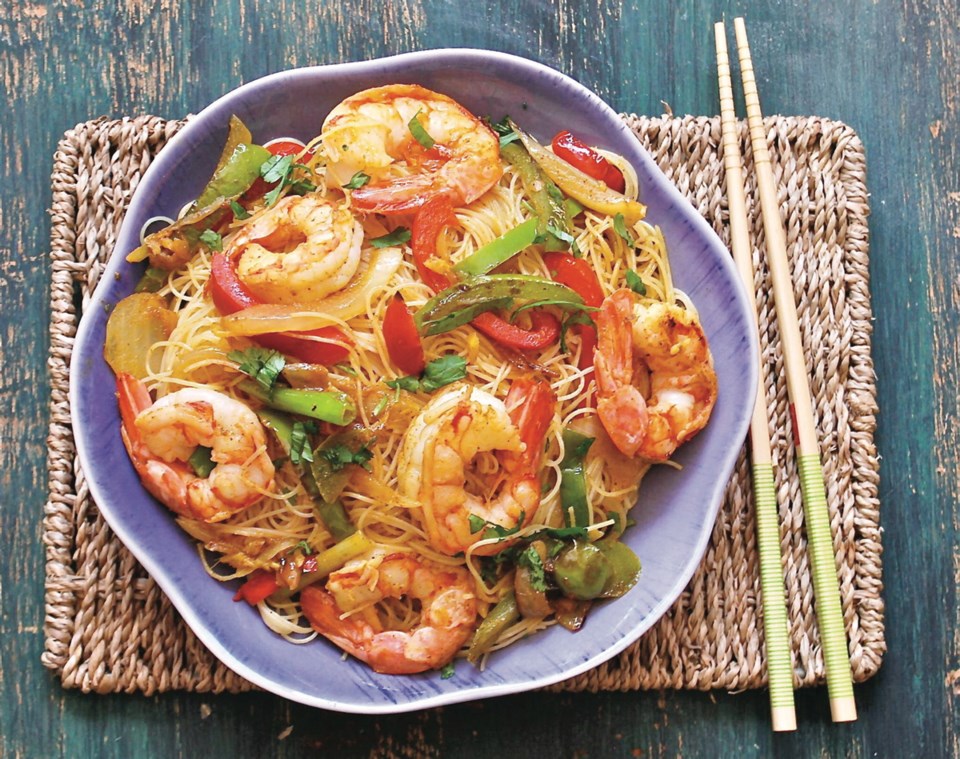In a recent column on menu planning for the COVID-19 crisis, I suggested home cooks include dishes that used ethnic ingredients. That was because I found ingredients such as Asian-style rice noodles to be widely available in grocery stores, while items such as pasta were in short supply.
I also made that suggestion because dishes made with those types of noodles are delicious, lift your spirits and make you feel good. Exactly how I felt when I made the Singapore noodles you see in today’s photo, which I dug into shortly after taking that picture.
Despite their name, Singapore noodles were not first cooked in Singapore. In fact, if you asked someone in Singapore about them they might have wondered what the heck you were talking about.
Lore suggests Singapore noodles were actually invented in Hong Kong in either the 1950s or 1960s, depending on the source. The story goes that the British, when they ruled Hong Kong, introduced curry powder to the region. Rice noodles were widely available, and at some point a clever chef created a dish combining the two.
Some speculate they were called Singapore noodles because it made them sound exotic, and Indian-style dishes, such as curry, are part of that city-state’s diverse cuisine.
Other ingredients, of course, were added to the curry powder-flavoured noodles, such as prawns, vegetables and other flavourings. Sliced Chinese-style barbecue pork and scrambled egg are also added to some versions of Singapore noodles.
Singapore noodles eventually began to be served in Chinese restaurants around the world, including those across Canada.
My home-cooked version is a simplified one that does not include the barbecue pork and scrambled egg. But you could certainly toss one or both of those items into the noodles, if desired.
Like many other dishes prepared in a wok or other large cooking vessel, Singapore noodles cook quickly. So, make sure you have all your ingredients prepped and ready to go before firing up the stove.
Note: Due to the nature of my work, I spend a lot of time in grocery and other foods stores. I must give high praise to the people working in those establishments during the COVID-19 crisis. It’s impossible not to notice how hard, and with such spirit and patience, they are working to ensure we can safely acquire food.
From the folks stocking shelves as quickly as they can at all hours of the day, to cashiers sanitizing their workstations in between each order, it’s been inspiring to see. Next time you’re shopping, give those workers a lift by saying thank you. It will make them and you feel good.
Singapore-style Noodles for Two
This recipe yields two nice servings of heavenly aromatic, curry-spiced noodles rich with prawns, vegetables and other flavourings such as fresh ginger and garlic.
Preparation time: 20 minutes
Cooking time: about 10 minutes
Makes: two servings
150 to 175 grams thin Asian-style rice noodles (see Note)
1 1/2 tsp sesame oil
2 Tbsp + 2 tsp vegetable oil (divided)
12 raw, medium or large prawns, peeled with tip of the tail portion left intact (see Eric’s options)
1/2 cup chicken or vegetable stock
1 Tbsp + 2 tsp soy sauce
1 Tbsp rice vinegar
1/2 medium green bell pepper, cut into strips
1/2 medium red bell pepper, cut into strips
1/2 medium onion, thinly sliced
2 tsp finely chopped fresh ginger
1 medium garlic clove, finely chopped
1 1/2 tsp mild or medium curry powder
2 green onions, each cut in half lengthwise, and then sliced, widthwise, into 1-inch pieces
• chopped cilantro, to taste (optional)
Bring eight cups of water to a boil. Place noodles in a wide, heatproof bowl. Pour the boiling water over noodles and soak 60 to 90 seconds, until softened (be careful not overcook them). Drain noodles well, cool in ice-cold water, drain well again and put back in the bowl. Toss noodles with the sesame oil and set aside for now.
Place 1 Tbsp of the vegetable oil in a very large skillet or wok set over medium-high heat. When oil is hot, add the prawns and cook about one minute per side, or until just cooked through. Remove pan from the heat, lift prawns out of it and set on a plate.
In a small bowl, combine the stock, soy sauce and vinegar.
Set the pan back over medium-high heat and add the remaining oil. When oil is hot, add the bell pepper and onion and stir fry two minutes. Add ginger, garlic and curry powder and cook and stir 30 to 60 seconds more.
Add the noodles, prawns, green onion and stock mixture and toss and cook two minutes, or until noodles are piping hot. Divide noodles between two shallow bowls, sprinkle with cilantro, if using, and enjoy.
Note: Dried, thin, Asian-style rice noodles, also called rice stick, bánh pho or vermicelli, are sold in the Asian foods aisle of grocery stores. Package sizes can vary. Remove what you need for this recipe, and save the rest for another time.
Eric’s options: I sometimes serve hoisin or oyster sauce alongside the noodles, to further flavour them at the table. The already cooked and peeled prawns sold at many grocery stores could replace the raw ones used in this recipe.
If you make that substitution, only cook them in the hot oil about one minute, just to take the chill out of them.
To make them easier to eat, if desired, you can snip and cut through the cooked noodles a few times with scissors before tossing and heating them with the other ingredients. That is something they would do in most Chinese restaurants.
You can also add 1 cup or so of bean sprouts to the noodles. If you do, add them when you pour in the stock mixture.
Eric Akis is the author of eight cookbooks. His columns appear in the Life section Wednesday and Sunday.



